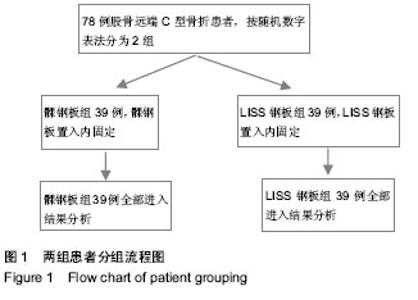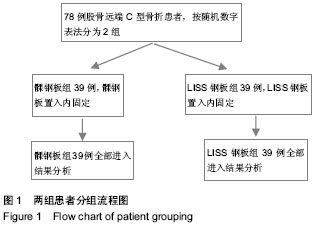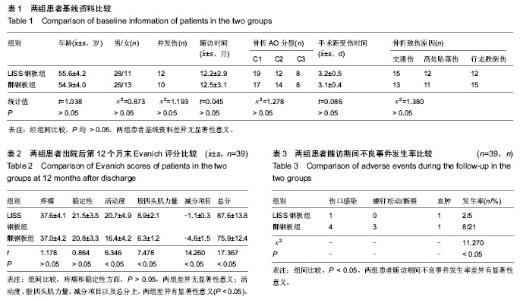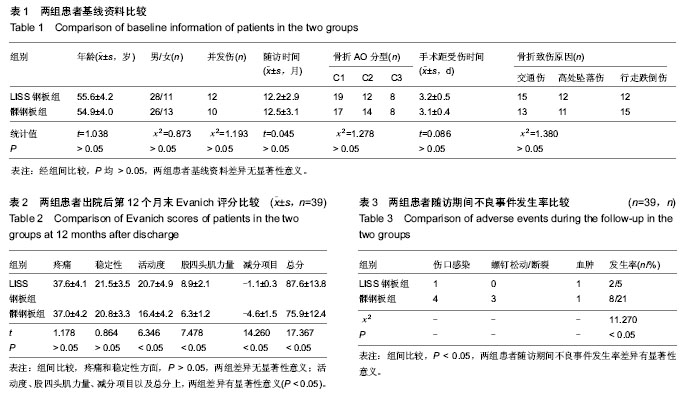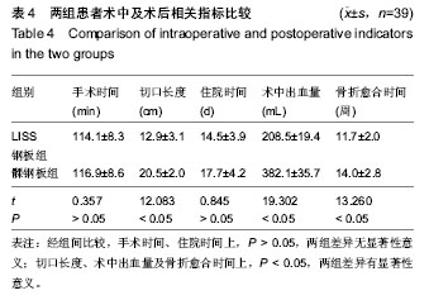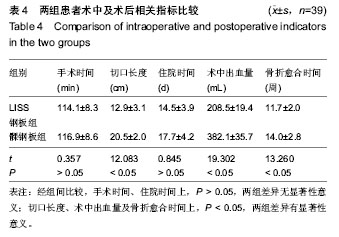| [1] Mostafa Mohamed F, El-Adl W, El-Sayed M, et al. Operative treatment of displaced Pipkin type I and II femoral head fractures. Arch Orthop Trauma Surg. 2014;134(5):637-644.
[2] 韩宁,孙贵新,李增春,等.PFNA及倒置LISS钢板治疗股骨近端骨折的对比研究[J].中华骨科杂志,2011,31(8):871-876.
[3] 张小兵.微创稳定系统与解剖钢板内固定治疗股骨远端骨折的对比观察[J].中国医药导报,2012, 9(13):68-69.
[4] 邬哲慧,黄玉良,许立.微创稳定系统(LISS)和股骨髁支撑钢板治疗老年股骨远端骨折的临床研究[J].右江民族医学院学报,2014,36(4):581-582.
[5] Valet S, Weisse B, Kuebler J, et al. Are asymmetric metal markings on the cone surface of ceramic femoral heads an indication of entrapped debris. Biomed Eng Online. 2014; 13(1):38.
[6] 闫斌.微创固定系统在股骨远端C3型骨折手术中的应用[J].航空航天医学杂,2012,23(2):194-195.
[7] 张名硕,贺胜,邵明.股骨远端骨折治疗进展[J].国际骨科学杂志, 2012,33(5):306-307.
[8] Park MS, Her IS, Cho HM, et al. Internal fixation of femoral head fractures (Pipkin I) using hip arthroscopy. Knee Surg Sports Traumatol Arthrosc. 2014;22(4):898-901.
[9] 王秀民.股骨髁部支撑钢板修复股骨远端骨折效果评价[J].中国组织工程研究,2014,18(26):4168-4172.
[10] 杨伟兵,李般若,王青平,等.LISS钢板治疗胫骨多段骨折[J].临床骨科杂志,2011,14(3):354-354.
[11] Berkes MB, Little MT, Lazaro LE,et al.Catastrophic failure after open reduction internal fixation of femoral neck fractures with a novel locking plate implant. Orthop Trauma. 2012; 26(10):e170-176.
[12] 尹雪峰.LISS钢板内固定治疗股骨远端复杂骨折20例疗效观察[J].山东医药,2010,50(22):75-76.
[13] Chimutengwende Gordon M,Khan W,Johnstone D.Recent advances and developments in knee surgery:principles of periprosthetic knee fracture management.Open Orthop J. 2012;15(6):301-304.
[14] Chen AF,Choi LE, Colman MW, et al. Primary versus secondary distal femoral arthroplasty for treatment of total knee arthroplasty periprosthetic femur fractures.J Arthroplasty. 2013;28(9):1580-1584.
[15] 杨康华,杨晶,杨广忠.三种内固定物治疗股骨远端骨折的稳定性比较[J].中国组织工程研究,2014,18(4):565-570.
[16] 王利宏,蒋恒,徐国红,等.倒置股骨远端LISS与DHS治疗股骨转子间骨折的疗效分析[J].中华关节外科杂志(电子版),2011,5(3): 374-378.
[17] Cao LH, Wang B, Li M, et al. Closed reduction and internal fixation versus total hip arthroplasty for displaced femoral neck fracture. Chin J Traumatol. 2014;17(2):63-68.
[18] Yoon PW, Kwak HS, Yoo JJ, et al. Subchondral insufficiency fracture of the femoral head in elderly people. J Korean Med Sci. 2014;29(4):593-598.
[19] Maini L, Batra S, Arora S, et al. Surgical dislocation of the hip for reduction of acetabular fracture and evaluation of chondral damage. J Orthop Surg (Hong Kong). 2014;22(1):18-23.
[20] 赵宇.股骨远端骨折LISS钢板内固定手术配合[J].中国卫生标准管理,2014,5(02):62-63
[21] 王宏川,庞贵根,曾宪铁,等.微创固定系统治疗股骨远端骨折53例[J].中华创伤骨科,2009,25(10):898-899
[22] Marchionatti E, Fecteau G, Desrochers A. Traumatic Conditions of the Coxofemoral Joint: Luxation, Femoral Head-Neck Fracture, Acetabular Fracture. Vet Clin North Am Food Anim Pract. 2014;30(1):247-264.
[23] 张雄.微创内固定系统与动力髁螺钉内固定治疗股骨远端骨折的临床疗效及安全性比较[J].河北医学,2014,20(4):581-584.
[24] 杨同,张谦,耿喜林,等.股骨髁部支撑钢板对股骨远端骨折手术疗效的影响因素分析[J].国际生物医学工程杂志,2014,37(4):222.
[25] 陈琦翔,柯文彬,王全权.带锁髁支持钢板内固定配合早期持续被动运动功能锻炼治疗股骨髁上骨折[J].广东医学,2013, 34(20): 3162-3163.
[26] 李程.AO股骨髁支撑钢板内固定在股骨远端复杂骨折的应用[J].中国修复重建外科杂志,2006, 20(7):706-707.
[27] 张小路,林其仁,叶晖.股骨远端微创固定系统与髁部支持钢板治疗骨远端C型骨折的疗效分析[J].中医正骨,2011,23(12):9-10.
[28] 李学金,温晓燕,许杰,等.LISS钢板内固定结合骨水泥治疗股骨远端动脉瘤样骨囊肿[J].中国组织工程研究,2013,17(39): 7009-7010.
[29] Doshi HK, Wenxian P, Burgula MV, et al. Clinical outcomes of distal femoral fractures in the geriatric population using locking plates with a minimally invasive approach. Geriatr Orthop Surg Rehabil. 2013; 4(1):6-20.
[30] 李鹏,苗娜,温晓燕,等.微创 Liss 钢板与髁支撑钢板治疗股骨远端粉碎性骨折的疗效观察[J].东南大学学报(医学版),2013,32(4): 458-460.
[31] Ehlinger M, Adam P, Arlettaz Y, et al. Minimally-invasive fixation of distal extra articular femur fractures with locking plates: Limita?tions and failures. Orthop Traumatol Surg Res. 2011;97(6): 652-658.
[32] 陈俞涛,杨江伟,侯海斌,等.微创内固定系统和髁支持钢板治疗股骨远端C型骨折的对比研究[J].天津医药,2014,55(4):378-380.
[33] 廖瑛扬,肖淼盛,张玉,等.解剖型钢板与髁钢板治疗股骨远端骨折比较[J].实用诊断与治疗杂志,2004,18(5):379-380.
[34] 杨维全.股骨远端髁钢板治疗股骨髁部复杂型骨折[J].中国矫形外科杂志,2006,14(14):1112-1113.
[35] 朱雅龙,吴金平,王永安,等.LISS内固定系统在老年性股骨粗隆间骨折中的应用[J].实用骨科杂志,2012,18(3):257-259.
[36] He D, Xue Y, Li ZY, et al. Effect of depression on femoral head avascular necrosis from femoral neck fracture in patients younger than 60 years. Orthopedics. 2014;37(3):e244-251.
[37] Homma Y, Miyahara S, Mogami A, et al. Percutaneous screw fixation for a femoral head fracture: a case report. Arch Orthop Trauma Surg. 2014;134(3):371-374.
[38] 盛晓文,陈兵乾,薛峰,等.微创技术LISS接骨板治疗股骨远端骨折[J].临床骨科杂志,2011,14(2):223-224.
[39] Durgaprasad Hegde S, D SR, B MM, et al. Alkaptonuric Arthropathy with Periprosthetic Fracture:A Case Report. J Clin Diagn Res. 2014;8(3):176-178.
[40] 李煜,于桂泳,尚洪涛,等.LISS钢板微创治疗胫骨平台骨折的临床效果[J].中国医药导刊,2014,11(2):209-210. |
